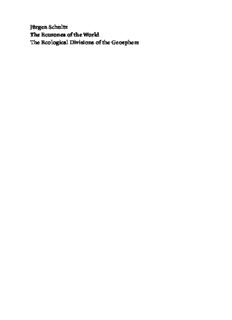
The Ecozones of the World: The Ecological Divisions of the Geosphere PDF
Preview The Ecozones of the World: The Ecological Divisions of the Geosphere
¨ JurgenSchultz TheEcozonesoftheWorld TheEcologicalDivisionsoftheGeosphere ¨ Jurgen Schultz The Ecozones of the World The Ecological Divisions of the Geosphere Translated into English by Bridget Ahnert Second Edition with144Figures,22Tables,and5Boxes 123 Author Translator Ju¨rgenSchultz BridgetAhnert GeographischesInstitut Karl-Christ-Str.15a Rheinisch-Westfälische 69118Heidelberg TechnischeHochschuleAachen(RWTH) Templergraben55 52056Aachen Germany ThisbookwasoriginallypublishedinGermanunderthetitle“DieÖkozonenderErde”,3.Auflage. ©2002byEugenUlmerGmbH&Co.,Stuttgart,Germany 1stEnglishEditionSpringer-Verlag,1995 ISBN-10 3-540-20014-2 SpringerBerlinHeidelbergNewYork ISBN-13 978-3-540-20014-7 SpringerBerlinHeidelbergNewYork LibraryofCongressControlNumber:2005924522 Thisworkissubjecttocopyright.Allrightsreserved,whetherthewholeorpartofthematerial isconcerned,specificallytherightsoftranslation,reprinting,reuseofillustrations,recitation, broadcasting,reproductiononmicrofilmorinanyotherway,andstorageindatabanks.Dupli- cationofthispublicationorpartsthereofispermittedonlyundertheprovisionsoftheGerman CopyrightLawofSeptember,9,1965,initscurrentversion,andpermissionforusemustalwaysbe obtainedfromSpringer-Verlag.ViolationsareliabletoprosecutionundertheGermanCopyright Law. SpringerisapartofSpringerScience+BusinessMedia springeronline.com ©Springer-VerlagBerlinHeidelberg2005 PrintedintheNetherlands Theuseofdesignations,trademarks,etc.inthispublicationdoesnotimply,evenintheabsenceof aspecificstatement,thatsuchnamesareexemptfromtherelevantprotectivelawsandregulations andthereforefreeforgeneraluse. Typesetting:LE-TEXJelonek,Schmidt&VöcklerGbR,Leipzig Coverdesign:E.Kirchner,Heidelberg Production:A.Oelschläger Printedonacid-freepaper 30/2132/AO 543210 V Preface Nine terrestrial ecozones are distinguished and described in separate chap- ters.Eachoftheseregionalchaptersissubdividedbythesameheadings,i.e. distribution, climate, relief and drainage, soil, vegetation and animals, and land use. The contents of the corresponding subdivisions have similar or- ganizations and use consistent terminology and units of measurement. This should help the reader greatly in finding and comparing information which especially interests him; e.g. he can easily find which soil units are charac- teristic for each of the ecozones or how ecozones differ with respect to soil units. Other features and processes handled in this way include weathering of rocks, erosion and sedimentation processes, soil formation, solar radi- ation, growing seasons, moisture regime, vegetation structure and dynam- ics, nutrient cycling, energy fluxes, ecosystem models, agricultural use and potential. Theregionalsectionwhichpresentsthenineindividualecozonesispreceded byageneralsectioninwhichnumerousecologicalterminiareintroducedand comparingoverviewsofselectedcharacteristicsaredescribed. Soil types are classifiedand named in accordance with the FAO-UNESCO classificationsystem,whichhasbeenutilizedinpreparingauniquedetailed soil map of the entire earth (and an even more detailed one covering the European Economic Community). With this map, internationally applicable soilterminologyhasbeenmadeavailableforthefirsttime.Theterminology maysoundsomewhatforeignto unaccustomedears, butthiswillnot bethe caseforlong.Thereadershouldnotlethimselfbeputoffbyforeign-sounding soilnames–hewillhavetolearnthemsoonerorlateranyway! This book was conceived mainly to serve students of geography. I would bepleasedif others also find interest init – studentsof biology, agricultural sciencesorforestry,andgeographyorbiologyteachersstrivingtofurthertheir knowledge,andallthoseinterestedinecologyandgeographywhowouldlike more information on the specific characteristics of the major regions of the earth, if only for the purpose of preparing themselves for a journey to an- other part of our planet. During my stays in foreign regions, I have at times wishedfor abookwhich–asistheintendedpurposeofthepresent volume – could have provided in concentrated form a summary and explanation of themostsignificantcharacteristicsofthemajorregionsoftheearthandtheir interactionswithoneanother. VI Thethemeofthebookinhandis(geo)ecology.Nothoweverinthecurrent prevailingsense,wherebythe(destructive)environmentaleffectsofmanand the protection of the environment from these influences have taken centre stage.Itismuchmoreconcernedwithfurnishinguswithinformationabout the nature of our environment, its form and the materials of its composite parts,aswellastheinteractionbetweenthem.Itgoeswithoutsayingthathope will be born for a greater understanding for the environment as well as its preservation. ¨ JurgenSchultz Aachen,August2004 Contents General:thetreatmentoftheecozonesandglobaloverviews ofselectedcharacteristics 1 Distribution 7 2 Climate 11 2.1 Solarradiation.................................................................... 11 2.2 Thegrowingseasonandconditionsforplantgrowth................ 14 3 Reliefanddrainage 17 3.1 Geomorphologicalprocesses ................................................ 17 3.2 Drainageandwaterbalance.................................................. 17 4 Soils 21 4.1 Soilfertility........................................................................ 21 4.2 Soilwaterbudget................................................................. 23 4.3 Soilunitsandsoilzones....................................................... 26 5 Vegetationandanimals 35 5.1 Structuralcharacteristicsofthevegetation ............................. 35 5.2 Ecosystemmodelofecozone................................................. 38 5.3 Availablesupplyoforganicmatterintheecosystem................. 40 5.4 Primaryproduction............................................................. 40 5.4.1 Photosynthesisandrespiration.................................... 40 5.4.2 Primaryproductionfromplantstands.......................... 42 5.4.3 Productioncapacityoftheworld’splantcover............... 43 5.5 Consumptionbyanimalsandsecondaryproduction................ 48 5.6 Wasteanddecomposition..................................................... 49 5.7 Turnoverofminerals........................................................... 51 6 Landuse 55 VIII Contents Regionalsection:Theindividualecozones 7 Polarsubpolarzone 63 7.1 Distribution....................................................................... 63 7.2 Climate.............................................................................. 64 7.2.1 Temperature,lengthofday,precipitation...................... 64 7.2.2 Annual temperature changes in the soil and air layer nexttothesoil.......................................................... 65 7.2.3 Summersolarradiationandheatbudget....................... 67 7.3 Reliefanddrainageinperiglacialareas................................... 68 7.4 Soils.................................................................................. 72 7.5 Vegetationandfaunainthetundraandpolardeserts............... 73 7.5.1 Distributionofvegetation........................................... 74 7.5.2 Biomassandprimaryproduction................................. 75 7.5.3 Animalsandanimalfeed............................................ 76 7.5.4 Decompositionandturnoverofminerals...................... 77 7.5.5 Modelofatundraecosystem....................................... 78 7.6 Landuse............................................................................ 80 Synopticdiagramforthetundra.................................................... 81 8 Borealzone 83 8.1 Distribution....................................................................... 83 8.2 Climate.............................................................................. 84 8.3 Reliefanddrainage.............................................................. 87 8.4 Soils.................................................................................. 89 8.5 Vegetationandanimals........................................................ 91 8.5.1 Borealconiferousforest.............................................. 91 8.5.2 Peatbogs.................................................................. 92 8.5.3 Foresttundra,polarandforesttreelines....................... 93 8.5.4 Biomassandprimaryproduction................................. 94 8.5.5 Decomposition,organicsoilmatterandmineralreserves 94 8.5.6 Borealconiferousforestecosystems.............................. 98 8.6 Landuse............................................................................ 98 SynopticdiagramfortheBorealzone.............................................100 9 Temperatemidlatitudes 103 9.1 Distribution.......................................................................103 9.2 Climate..............................................................................103 9.3 Reliefanddrainage..............................................................105 9.4 Soils..................................................................................107 9.5 Vegetationandanimals........................................................108 9.5.1 Seasonalityindeciduousforests ..................................109 9.5.2 Waterbudgetinforests...............................................111 9.5.3 Biomassandprimaryproduction,growth andlitterproduction..................................................112 Contents IX 9.5.4 Mineralbudgetinmidlatitudedeciduousbroadleaf andborealconiferousforests.......................................113 9.5.5 Modelofanecosystemofadeciduousforest..................118 9.6 Landuse............................................................................118 SynopticdiagramfortheTemperatemidlatitudes............................121 10 Drymidlatitudes 123 10.1 Distribution.......................................................................123 10.2 Climate..............................................................................124 10.3 Reliefanddrainage..............................................................125 10.4 Soilsinthesteppes..............................................................125 10.4.1 Typesofsoilinthezone .............................................125 10.4.2 Halomorphicsoils.....................................................128 10.5 Vegetationandanimalsinthesteppes....................................128 10.5.1 Typesofsteppes........................................................129 10.5.2 Life-form and adaptation to winter cold and summer drought....................................................................130 10.5.3 Animals...................................................................130 10.5.4 Biomass,primaryproductionanddecomposition..........131 10.5.5 Availablesupplyandturnoverofminerals.....................134 10.6 Landuse............................................................................134 10.6.1 Largescalegraincultivation........................................134 10.6.2 Extensivepastureeconomy.........................................136 Synopticdiagramforsteppes........................................................138 11 Subtropicswithwinterrain 141 11.1 Distribution.......................................................................141 11.2 Climate..............................................................................142 11.3 Reliefanddrainage..............................................................143 11.4 Soils..................................................................................143 11.5 Vegetationandanimals........................................................144 11.5.1 Sclerophyllousvegetation ...........................................144 11.5.2 Adaptationtosummerdrought ...................................146 11.5.3 Animals...................................................................148 11.5.4 Fire .........................................................................148 11.5.5 Biomassandprimaryproduction.................................150 11.6 LandUse............................................................................152 SynopticdiagramfortheSubtropicswithwinterrain.......................154 12 Subtropicswithyear-roundrain 157 12.1 Distribution.......................................................................157 12.2 Climate..............................................................................158 12.3 Reliefanddrainage..............................................................159 12.4 Soils..................................................................................160 12.5 Vegetation..........................................................................161 12.5.1 Structuralcharacteristics............................................161 X Contents 12.5.2 Availablesupplyandturnoverinasemi-evergreenoak forestinthesoutheasternUnitedStates ........................162 12.6 Landuse............................................................................165 SynopticdiagramfortheSubtropicswithyear-roundrain.................165 13 Drytropicsandsubtropics 169 13.1 Distribution.......................................................................169 13.2 Climate..............................................................................170 13.3 Reliefanddrainage..............................................................172 13.3.1 Weatheringprocessesandcrusts..................................172 13.3.2 Aeolianprocesses......................................................172 13.3.3 Streamerosionandwashdenudation...........................173 13.4 Soils..................................................................................174 13.5 Vegetationandanimals........................................................175 13.5.1 Vegetationandsoilwaterbudget..................................176 13.5.2 Adaptationtodroughtandstress.................................180 13.5.3 Animalsinthedesert.................................................183 13.5.4 Biomassandprimaryproduction.................................184 13.6 Landuse............................................................................185 13.6.1 Pastoralnomadism....................................................185 13.6.2 Oasisagriculture.......................................................187 Synopticdiagramfortropicalthornsavannasandsubtropicalthorn...189 steppesinthesemi-aridDrytropicsandsubtropics..........................189 14 Tropicswithsummerrain 193 14.1 Distribution.......................................................................193 14.2 Climate..............................................................................194 14.3 Reliefanddrainage..............................................................195 14.4 Soils..................................................................................198 14.4.1 General characteristics of soils in the subtropics and tropicswithsummerandyear-roundrain.....................198 14.4.2 Soiltypes .................................................................200 14.5 Vegetationandanimals........................................................202 14.5.1 Structuralcharacteristicsofsavannavegetation.............202 14.5.2 Animals...................................................................203 14.5.3 Savannafires.............................................................204 14.5.4 Biomassandprimaryproduction.................................204 14.5.5 Zoomassandanimalfeed...........................................206 14.5.6 Decompositionoflitter...............................................208 14.5.7 Mineralsuppliesandturnovers ...................................209 14.6 Landuse............................................................................210 SynopticdiagramfortheTropicswithsummerrain.........................213 15 Tropicswithyear-roundrain 215 15.1 Distribution.......................................................................215 15.2 Climate..............................................................................216 Contents XI 15.3 Reliefanddrainage..............................................................217 15.4 Soils..................................................................................218 15.5 Vegetationandanimals........................................................221 15.5.1 Structureofthetropicalrainforest...............................221 15.5.2 Dynamicsofthevegetation.........................................224 15.5.3 Animals...................................................................224 15.5.4 Biomassandprimaryproduction.................................225 15.5.5 Animalfeed..............................................................226 15.5.6 Litter,thelitterlayer,decompositionandhumus............226 15.5.7 Mineralsuppliesandturnovers ...................................227 15.5.8 Rainforestecosystem .................................................229 15.6 Landuse............................................................................230 SynopticdiagramfortheTropicswithyear-roundrain.....................235 References 237
Description: